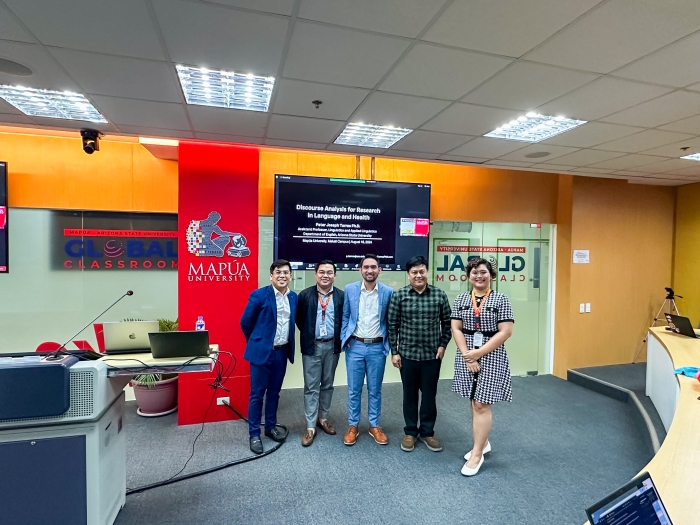Linguistics work could improve doctor-patient communications in Philippines, beyond

Peter Torres, a professor of linguistics in The College of Liberal Arts, visited Mapúa University as part of the ASU Cintana Alliance network to share his research on how linguistic analysis helps understand the vocal cues patients use in various contexts. The Philippines provide a large pipeline of health care workers for the U.S. and Arizona. Photo courtesy of Peter Torres
When Peter Torres traveled to Mapúa University in the Philippines over the summer, he was shocked to see a billboard promoting Arizona State University.
“It wasn’t even near the university,” said Torres, an assistant professor of linguistics in The College of Liberal Arts and Sciences. “It was just in the streets somewhere.”
The billboard, located more than 7,500 miles away from Tempe, advertises how ASU, through a partnership with Cintana Education, is seeking to create the largest university network in the world through the ASU Cintana Alliance network.
ASU has partnered with more than two dozen universities across the world — in places like Kyiv, Ukraine; Almaty, Kazakhstan; and Punjab, India — to share best practices across fields of study, offer exchange opportunities for students and faculty, and provide dual-degree programs.
Torres was the first ASU scholar to visit Mapúa University. He presented research from his study, which examines how linguistic analysis helps understand the vocal cues patients use in various contexts.
His study found that patients lower their pitch and use a creaky voice when discussing morally fraught topics, such as experiencing chronic pain and requesting opioids.
ASU News talked to Torres about his experience and the Cintana Alliance Network.
Note: The interview has been edited for clarity and brevity.
Question: What prompted your study?
Answer: I grew up in the Philippines and am very familiar with the country. The Philippines is an emerging market in Southeast Asia, and language and health in the Philippines is not as studied as it is in Western countries, so there's a lot of room for research. In fact, many health care workers in the U.S. and in Arizona come from the Philippines, and they go to universities like Mapúa University for training. The information and data gathered from the classrooms and the trainings is important because it emerges in one way or the other in health care in the U.S.
I thought it would be a great opportunity for ASU to collaborate with Mapúa as they build up their new School of Health Sciences. I think the partnership with ASU is very significant because studying in medical school and moving somewhere to work becomes more of a reality when the university that you are in is actually collaborating with the university abroad.
Q: What does your study entail?
A: I study how people talk about their pain, particularly surrounding the opioid crisis. On my visit there, I was talking about doctor-patient communication. It’s really relating the humanities with the sciences to give (students and faculty at Mapúa) a better idea of what communication is like here because that’s one of the common barriers for immigrant workers in the United States.
The one thing that hinders them from migrating and working here and joining the American workforce is the communication aspect. And so, how do patients talk about their pain and how do physicians react? How do patients react when their opiates are being taken away from them?
Because policies are forcing physicians to take away patients’ opiates, it’s creating awkward conversations and a lot of fighting in the medical space. And that is something that people need to be prepared for.
Q: In what way?
A: My study really revolves around how providers pay attention to a patient’s pain. And how do they address policy issues in the medical space? Meaning, how do they enact policies that make for these awkward conversations when opiates are less available? Because if you are a health care worker, that’s one of the issues that really gives you stress. It can be the source of contention that just ruins people’s days. So, when I went there, I was talking about the strategies that I noticed physicians use to get around this.
Q: What strategies?
A: So, when patients start talking, they might change their pitch or change their tone. It might cue physicians, nursing assistants or health care workers that the patient might be hinting at something that is fraught or awkward for them. That will cue the physician to change the conversation or move the conversation toward something else so it doesn’t become a heated conversation.
Q: How important is the work ASU is doing through the Cintana Alliance?
A: The Philippines is not the richest country in the world, and I feel like it will benefit from the resources that ASU provides. The idea of improving health care communication is the bigger picture that could come out of this collaboration. I didn’t realize the weight of the visit until I got there and saw all the ASU signs. What they told me is that by me visiting there and giving a talk about my research, it (inspired them) to lean into their research and it made the partnership more tangible. I think it made people very, very hopeful.
We talked about what the Cintana program is trying to promote, too, and they started pitching ideas of how they could gather data in their own classrooms, like recordings from psychology sessions. I was like, “ASU would love that” because then we’re gathering data from abroad. This partnership could result in a lot of studies and innovation.
More Health and medicine

Dynamic data duo advances health research
The latest health research promises futuristic treatments, from cancer vaccines to bioengineered organs for transplants to medical nanobots. While these technologies may one day be…

New study reveals high levels of toxins in seized cannabis from Arizona and California
A recent study conducted by researchers from Arizona State University has uncovered alarming levels of Fusarium mycotoxins in illicit cannabis samples seized in Arizona and California.The study found…

PhD student builds bridges with construction industry to prevent heat-related illnesses
It is no secret that Arizona State University has innovative researchers working to help solve everyday problems.According to a new preliminary report issued by Maricopa County, there were more…


